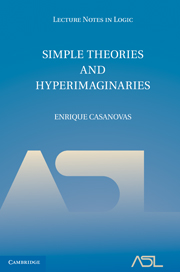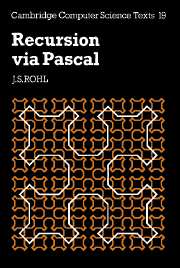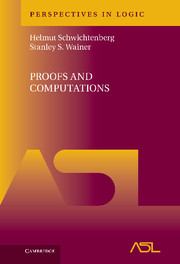Refine search
Actions for selected content:
5849 results in Programming Languages and Applied Logic
APPENDIX A - SET THEORY
-
- Book:
- A Course in Model Theory
- Published online:
- 05 June 2012
- Print publication:
- 08 March 2012, pp 185-190
-
- Chapter
- Export citation
CHAPTER 5 - ℵ1-CATEGORICAL THEORIES
-
- Book:
- A Course in Model Theory
- Published online:
- 05 June 2012
- Print publication:
- 08 March 2012, pp 63-88
-
- Chapter
- Export citation
CHAPTER 3 - QUANTIFIER ELIMINATION
-
- Book:
- A Course in Model Theory
- Published online:
- 05 June 2012
- Print publication:
- 08 March 2012, pp 27-46
-
- Chapter
- Export citation
INDEX
-
- Book:
- A Course in Model Theory
- Published online:
- 05 June 2012
- Print publication:
- 08 March 2012, pp 239-248
-
- Chapter
- Export citation
PREFACE
-
- Book:
- A Course in Model Theory
- Published online:
- 05 June 2012
- Print publication:
- 08 March 2012, pp ix-x
-
- Chapter
- Export citation

Simple Theories and Hyperimaginaries
-
- Published online:
- 05 March 2012
- Print publication:
- 30 June 2011

Recursion via Pascal
-
- Published online:
- 05 February 2012
- Print publication:
- 26 July 1984

Proofs and Computations
-
- Published online:
- 05 January 2012
- Print publication:
- 15 December 2011
Contents
-
- Book:
- Proofs and Computations
- Published online:
- 05 January 2012
- Print publication:
- 15 December 2011, pp vii-viii
-
- Chapter
- Export citation
PREFACE
-
- Book:
- Proofs and Computations
- Published online:
- 05 January 2012
- Print publication:
- 15 December 2011, pp ix-xiv
-
- Chapter
- Export citation
Part 2 - Provable recursion in classical systems
-
- Book:
- Proofs and Computations
- Published online:
- 05 January 2012
- Print publication:
- 15 December 2011, pp 147-148
-
- Chapter
- Export citation
CHAPTER 7 - EXTRACTING COMPUTATIONAL CONTENT FROM PROOFS
- from Part 3 - Constructive logic and complexity
-
- Book:
- Proofs and Computations
- Published online:
- 05 January 2012
- Print publication:
- 15 December 2011, pp 313-394
-
- Chapter
- Export citation
Part 1 - Basic proof theory and computability
-
- Book:
- Proofs and Computations
- Published online:
- 05 January 2012
- Print publication:
- 15 December 2011, pp 3-4
-
- Chapter
- Export citation
CHAPTER 5 - ACCESSIBLE RECURSIVE FUNCTIONS, ID<ω AND Π-CA0
- from Part 2 - Provable recursion in classical systems
-
- Book:
- Proofs and Computations
- Published online:
- 05 January 2012
- Print publication:
- 15 December 2011, pp 195-246
-
- Chapter
- Export citation
INDEX
-
- Book:
- Proofs and Computations
- Published online:
- 05 January 2012
- Print publication:
- 15 December 2011, pp 457-465
-
- Chapter
- Export citation
Part 3 - Constructive logic and complexity
-
- Book:
- Proofs and Computations
- Published online:
- 05 January 2012
- Print publication:
- 15 December 2011, pp 247-248
-
- Chapter
- Export citation
CHAPTER 1 - LOGIC
- from Part 1 - Basic proof theory and computability
-
- Book:
- Proofs and Computations
- Published online:
- 05 January 2012
- Print publication:
- 15 December 2011, pp 5-60
-
- Chapter
- Export citation
CHAPTER 2 - RECURSION THEORY
- from Part 1 - Basic proof theory and computability
-
- Book:
- Proofs and Computations
- Published online:
- 05 January 2012
- Print publication:
- 15 December 2011, pp 61-112
-
- Chapter
- Export citation
CHAPTER 8 - LINEAR TWO-SORTED ARITHMETIC
- from Part 3 - Constructive logic and complexity
-
- Book:
- Proofs and Computations
- Published online:
- 05 January 2012
- Print publication:
- 15 December 2011, pp 395-430
-
- Chapter
- Export citation
CHAPTER 6 - COMPUTABILITY IN HIGHER TYPES
- from Part 3 - Constructive logic and complexity
-
- Book:
- Proofs and Computations
- Published online:
- 05 January 2012
- Print publication:
- 15 December 2011, pp 249-312
-
- Chapter
- Export citation
